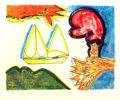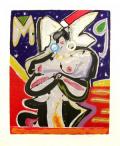enquiries@muka.co.nz
HANLY, Pat
Nationality: New Zealand
Website: Website
New Zealand artist
Born in Christchurch 1932
Died in Auckland 2004
Pat Hanly is one of New Zealand?s greatest artists. His paintings? palpable visual energy speaks powerfully of his passion for art and life. Working in Britain in the late 1950?s, early 1960?s, Pat absorbed Picasso, Chagall, Bacon and Abstract Expressionism. Coming home in 1962 he discovered a burgeoning art scene and become one of a new generation of artists optimistic about the future of art in this country, finding it possible to sustain a full-time art practice.
Pat revelled in what paint can do. He developed a fresh and distinctive visual language, with an absolute commitment to high key colour. Some works have dealt with transcendental themes; others with immediate political concerns - French testing in the Pacific and the bombing of the Rainbow Warrior, Arpartheid and the Springbok tour.
Pat Hanly has been one of the most visibly politically active New Zealand artists. Though not a political leader he has contributed significantly to the visibility of the antinuclear debate in New Zealand, not out of a populist trendiness but out of an idealistic and instinctive concern for balance as principle. He once commented, ?The majority of my works are usually in the subject area of social commentary issues, also life enhancing images when they occur in my observations?
Community was crucial for Pat. Born in Palmerston North, he went to art school in Christchurch, but ultimately settled in Auckland. His depictions of his home suburb Mt Eden and the Waitemata Harbour capture some of its faces. Pat said, ?One?s life is a responsibility to make with it and from it the most fruitful contribution directly to mankind.?
To Hanly content is an Essence (capitalized, universal) which flows, unperturbed, through time and space, the Universe, a garden or his work. It?s not a matter of thinking, it?s one of just being.
The female figure, peace dove and God?s eye are a common heritage; in Hanly?s hands they are softened, the triangle usually surrounding the God?s eye becomes a heart, the woman and dove shapes fill out and acquire a fluidity of line. Such symbols or a dribble of action applied paint contrast sharply with the formality of the overall spatial arrangements of his canvas. The looseness offset against rigidity are yin and yang to Hanly.
The desire for continuity and wholeness has driven Hanly to consciously attempt to achieve continuity in his life oeuvre ? artistic and personal ? surpassing that of the individual work/moment
Born in Christchurch 1932
Died in Auckland 2004
Pat Hanly is one of New Zealand?s greatest artists. His paintings? palpable visual energy speaks powerfully of his passion for art and life. Working in Britain in the late 1950?s, early 1960?s, Pat absorbed Picasso, Chagall, Bacon and Abstract Expressionism. Coming home in 1962 he discovered a burgeoning art scene and become one of a new generation of artists optimistic about the future of art in this country, finding it possible to sustain a full-time art practice.
Pat revelled in what paint can do. He developed a fresh and distinctive visual language, with an absolute commitment to high key colour. Some works have dealt with transcendental themes; others with immediate political concerns - French testing in the Pacific and the bombing of the Rainbow Warrior, Arpartheid and the Springbok tour.
Pat Hanly has been one of the most visibly politically active New Zealand artists. Though not a political leader he has contributed significantly to the visibility of the antinuclear debate in New Zealand, not out of a populist trendiness but out of an idealistic and instinctive concern for balance as principle. He once commented, ?The majority of my works are usually in the subject area of social commentary issues, also life enhancing images when they occur in my observations?
Community was crucial for Pat. Born in Palmerston North, he went to art school in Christchurch, but ultimately settled in Auckland. His depictions of his home suburb Mt Eden and the Waitemata Harbour capture some of its faces. Pat said, ?One?s life is a responsibility to make with it and from it the most fruitful contribution directly to mankind.?
To Hanly content is an Essence (capitalized, universal) which flows, unperturbed, through time and space, the Universe, a garden or his work. It?s not a matter of thinking, it?s one of just being.
The female figure, peace dove and God?s eye are a common heritage; in Hanly?s hands they are softened, the triangle usually surrounding the God?s eye becomes a heart, the woman and dove shapes fill out and acquire a fluidity of line. Such symbols or a dribble of action applied paint contrast sharply with the formality of the overall spatial arrangements of his canvas. The looseness offset against rigidity are yin and yang to Hanly.
The desire for continuity and wholeness has driven Hanly to consciously attempt to achieve continuity in his life oeuvre ? artistic and personal ? surpassing that of the individual work/moment




